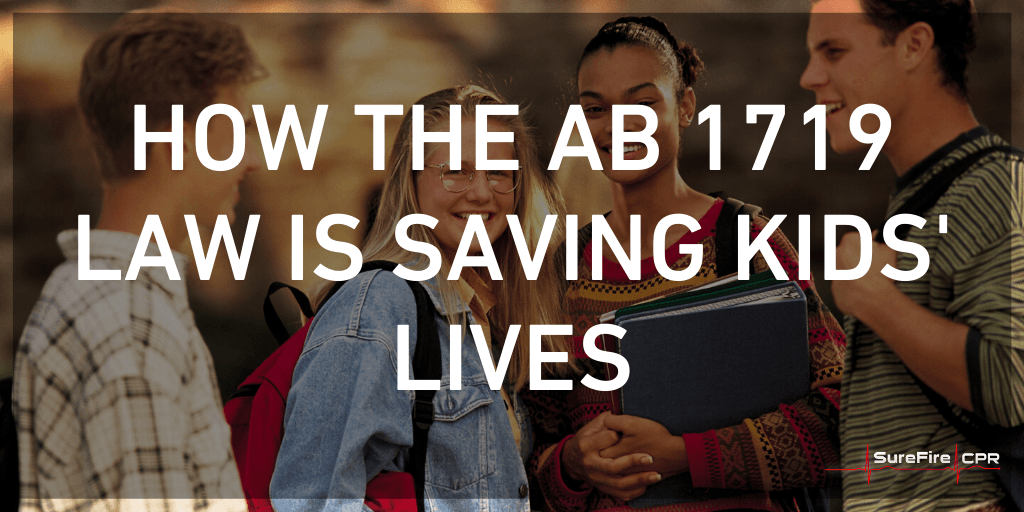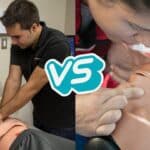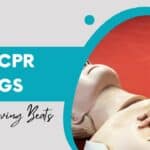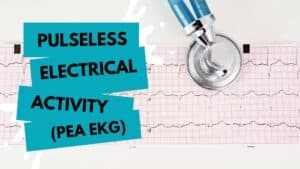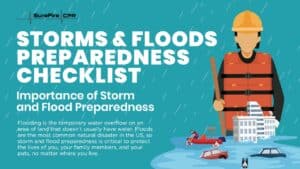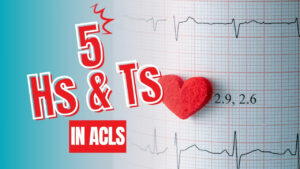For a little over a year, the AB 1719 Law has been in effect in California’s high schools. Safety officials and teachers statewide agree that this law has made a great impact in improving safety-preparedness for high school students. In short, AB 1719 requires all California high school health courses to teach compression-only CPR, an essential life-saving technique. In this guide, we dive deeper into AB 1719 to explain what it is and why it’s so beneficial. Read on to learn more about how the AB 1719 law is saving kids’ lives, and enroll in an award-winning CPR certification course here at SureFire CPR today!
What is CPR?
Before learning the ins and outs of the AB 1719 Law, it’s important to understand what the law requires: CPR. Short for cardiopulmonary resuscitation, CPR is a life-saving technique that incorporates chest compressions and (if necessary) artificial ventilation to restore breathing and spontaneous blood circulation for individuals who have suffered cardiac arrest. After calling 911, administering CPR is the next step for those who are unresponsive, breathing abnormally, or not breathing at all.
In the event of cardiac arrest, it is important to get the heart started before all else. The heart and the brain are our two most vital organs, and if the heart stops, so does the brain. This is why it’s important to begin with chest compressions and keep them going throughout CPR. The importance of chest compressions in CPR leads us into AB 1719, which is discussed in-depth in the following section.
All About AB 1719
AB 1719 is a newly-implemented California state law that requires all high school health classes to include compression-only CPR instruction. Put simply, if your student is taking a high school health class in California, he or she will learn how to do compression-only CPR. Compression-only CPR is CPR that uses only chest-compressions — not artificial ventilation via mouth-to-mouth resuscitation — to drive circulation in the event of cardiac arrest.
So, what is mandated by the AB 1719 law? First: all high schools with required health courses must include a compression-only CPR instruction in those same health courses. Second: school districts or charters without a health course requirement do not need to create one to satisfy the AB 1719 law. In other words: if your child’s school doesn’t require a health class, it doesn’t suddenly need one because of AB 1719. (That being said, it is highly recommended that you enroll your student in a school district that requires all high schoolers to complete at least one health class to graduate.)
According to the AB 1719 law, what must be included in CPR instruction for relevant school courses? Per the stipulations of AB 1719 (in Chapter 556, Statutes of 2016 of the California State Education Code), compression-only CPR instruction must include two things:
- An instructional program based on national evidence-based emergency cardiovascular care guidelines for the performance of compression-only CPR; and
- Instruction that includes a hands-on practice to support the learning of compression-only CPR.
Item number one stipulates that chest-only CPR instruction should be evidence-based, which means its instructors (teachers) should have learned CPR from a nationally-accredited source. (This is best done by earning a CPR certification through a course accredited by the American Red Cross or the American Heart Association.) Item number two stipulates that instruction should include hands-on practice for students while re-emphasizing that compression-only CPR is the only type of CPR that should be taught and practiced. In the section below, we dive deeper into AB 1719’s insistence on compression-only CPR as opposed to CPR with mouth-to-mouth ventilation.
Why Compression-Only CPR?
If you’ve read this far in our guide, you’ve undoubtedly noticed that the AB 1719 law states that compression-only CPR is the only type of CPR that should be taught in high school classes. If you’ve heard about CPR beyond this guide, you may know that there is another kind: CPR with chest compressions and mouth-to-mouth resuscitation. Why does AB 1719 call for compression-only CPR instruction?
The answer is that chest compressions are far more important than mouth-to-mouth resuscitation when it comes to CPR. In fact, the American Heart Association recommends using only chest compressions for those who are not extensively trained in CPR. Keeping the heart beating is crucial to keeping an individual alive, and improperly administered breaths can excessively halt chest compressions, which act as artificial heartbeats during cardiac arrest. Another reason why mouth-to-mouth resuscitation is not required by AB 1719 is that practicing mouth-to-mouth resuscitation requires more resources. CPR dummies must come with removeable mouthpieces that must be cleaned after each use. This is a time and resource cost — not to mention a hygiene risk — that lawmakers believe schools should not have to shoulder.
Why is AB 1719 So Important?
Cardiac arrest is one of the biggest killers in the United States. According to data from the American Heart Association, roughly 475,000 people in the United States die from cardiac arrest each year. In many of these cases, properly-administered CPR could have saved lives. When more people know CPR, more lives are saved. AB 1719 brings an essential life-saving skillset to every California high school student enrolled in a mandatory health class. It empowers students to save lives.
Preparing for AB 1719: Steps for Educators
If you are a school teacher or administrator preparing for AB 1719 in your health class, the first thing you need to do is get educated. You need to ensure that whoever is teaching your school’s health classes knows how to teach CPR per the AB 1719 law stipulations. The best way to do this is to enroll yourself and/or your educators in a CPR certification course. Lasting only a few hours, an accredited CPR course will teach you everything you need to know about administering CPR, all while guiding to hone your skills with hands-on practice. By the end of the course, you will receive a CPR certification good for two years. You can then use the knowledge and skills you learn in your CPR course to teach high school students in accordance with AB 1719 stipulations.
SureFire CPR: Your Trusted Partner in CPR Certification
Searching for a high-quality, comprehensive CPR certifications course in Southern California? Our team here at SureFire CPR has you covered. Our award-winning team proudly offers CPR certification accredited by the American Heart Association to individuals and groups across Southern California. Our CPR certification courses are taught by highly experienced instructors and fulfills the CPR requirement for the California Teaching Credential. When you enroll in CPR certification course with us, here’s what you’ll learn:
- How to Administer Adult, Child and Infant CPR
- How to Use an Automated External Defibrillator (AED) and Special Considerations
- How to Assist Conscious and Unconscious Choking Victims
With an extensive selection of class times and convenient course locations across Southern California, we have class options to fit into any educator’s schedule. Interested in learning more? Visit our CPR Certification page to read up on our course and schedule from our wide selection of classes. Also, be sure to explore our website to check out the many different world-class safety certification courses we offer. Have questions about AB 1719 or CPR in general? Contact us!
Sources
AB-1719 Pupil instruction: cardiopulmonary resuscitation. California State Education Code. Assembly Bill No. 1719. Chapter 556. 2015 – 2016.
Hands-only CPR frequently asked questions. American Heart Association. February 2019.
What is CPR? American Heart Association.

